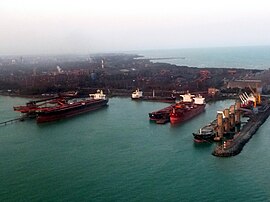Porto de Tubarão
| Porto de Tubarão | ||
|---|---|---|
|
Coordinates: 20 ° 17 ′ S , 40 ° 15 ′ W Porto de Tubarão on the map of Espírito Santo
|
||
| Basic data | ||
| Country |
|
|
| State |
|
|
| Detailed data | ||
| Time zone | UTC −3 | |
| Website | ||
| Partial view of the port | ||
The port of Porto de Tubarão is a place in Brazil in the Vitória district , capital of the Espírito Santo state . The port consists of a bulk cargo terminal for the handling of iron ore and has a large draft, which also allows larger bulk carriers, bulk carriers , to dock here. It is now one of the largest ore export ports in the world.
history
The port was inaugurated in 1966 and is operated by the largest mining company in Brazil, VALE SA, formerly known as Companhia Vale do Rio Doce . Construction of the port of Porto de Tubarão began in 1962 when the mining group VALE negotiated the first long-term contracts with customers in Japan and Germany. The port construction was paid for exclusively by taxpayers' money, as VALE had not yet been privatized and was state-owned at the time. The construction of the port was a technical challenge in terms of dimensions. The construction was carried out in cooperation with Japanese companies and introduced new methods of loading iron ore in the seaport. A direct consequence of this was the construction of super ships that exceeded all previously known sizes. The new loading concepts could also be partially transferred to liquid bulk cargo (petroleum). The ore terminal is directly connected to a railroad owned by VALE that brings iron ore directly from the Minas Gerais mine belt . In addition, VALE now owns the third largest fleet of bulk carriers in the world with Docenave .
The construction of the port of Porto de Tubarão went through some difficulties in terms of its financing. Approved US loans were canceled again, but ultimately the Brazilian state managed to raise the necessary money for them. Thanks to the foresight of the port's designers, who designed the size of the ore terminal for ships that did not even exist at the time (up to 300,000 GRT), the Porto de Tubarão is still one of the main axes of Brazilian ore handling today. The pioneering act of construction led to a number of follow-up projects and new investments after 1966, which were located in the area of Porto de Tubarão :
- Celulose Nipo Brasileira SA - Cenibra (cellulose and paper)
- Companhia Siderúrgica de Tubarão (steel industry)
- Albrás - Alunorte (aluminum),
- Mineração da Serra Geral (iron ore processing)
- CSI Califórnia Steel Industries / Joint venture between VALE and Kawasaki (steel processing)
environment
The settlement of industries in the Vitória area caused severe environmental damage, as little thought was given to this topic, especially in the first years of production. The black dust became known in the region because it caused severe health damage to the population in the area. But also problems in the area of marine pollution due to the high number of ship calls and water pollution by the settled industries did not fail to appear and are still causing major problems in the region today.

